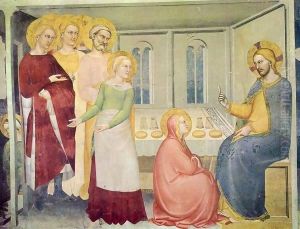Giovanni Da Milano Paintings
Giovanni da Milano, also known as Giovanni di Jacopo or Giovanni da Milano, was an Italian painter who was active during the mid-14th century. His exact date of birth is not known, and details about his early life are scarce. He is believed to have been born in Milan, which is suggested by his name 'da Milano,' meaning 'from Milan.'
Giovanni's work is associated with the Gothic style, which was prevalent in Europe during that time. He is known to have been in Florence from about 1346, and his presence there is documented until around 1369, the year of his death. Giovanni was influenced by the works of Giotto and his school, as well as by northern European art, which can be seen in the emotional expressiveness and detailed naturalism of his figures.
One of Giovanni da Milano's most significant contributions to the art world was his advancement of the International Gothic style, characterized by elegant and graceful figures, vibrant colors, and intricate ornamentation. He was capable of combining the Gothic style with the emerging humanist approach to painting.
His works include a series of frescoes in the Rinuccini Chapel at the church of Santa Croce in Florence, which are considered some of his finest. These works depict scenes from the lives of the Virgin and St. John the Baptist. The frescoes are noted for their narrative clarity and the use of color, which shows Giovanni's skill in creating depth and volume.
Giovanni da Milano's paintings are also characterized by their devotional intensity and often feature complex iconography. He was adept at both fresco and tempera painting, and his works can be found in various churches and collections throughout Italy.
Despite his significant contributions to the art of his time, Giovanni da Milano is not as well-known as some of his contemporaries. Nevertheless, his work provides valuable insights into the transitional period between the Medieval and Renaissance eras in Italian art. His influence can be seen in the work of later Italian painters who continued to develop the style that he helped to advance.






















